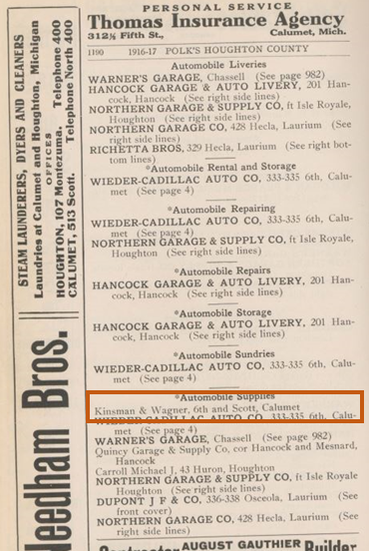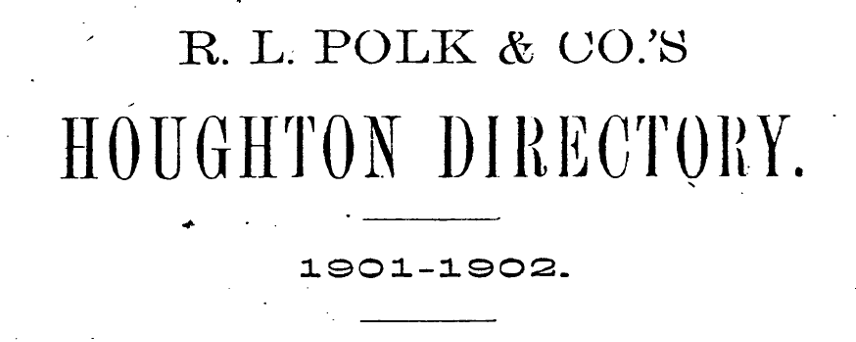|
This is part 2 of a 3-part blog series introducing the new historical business directories that you can explore in the Keweenaw Time Traveler. Last week, we discussed general information on historic city and business directories. This week, we want to shift our focus to specific historic directories and how our team mapped residents in the Keweenaw Time Traveler Explore App. What Copper Country directories exist, and where can you read them? Our directories were published by two different printers. The earliest set of records are A. H. Holland’s Handbook and Guide to Hancock & Houghton, Michigan which was published for 1887-1888. By 1895-1896, R. L. Polk and Company began publishing their Houghton County Directory, replacing Holland, and continued publishing through 1939. The University Archives and Historical Collections, housed in the Van Pelt and Opie Library’s Garden Atrium at Michigan Technological University, maintains the following collection of City Directories : Who was R. L. Polk? Ralph Lane Polk was born on September 12, 1849 in Ohio and later educated in New Jersey. He became a successful publisher in Detroit, Michigan specializing in city business directories and state gazettes (Herringshaw 1914). Herringshaw, Thomas William. Herringshaw’s National Library of American Biography: Contains Thirty-Five Thousand Biographies of the Acknowledged Leaders of Life and Thought of the United States; Illustrated with Three Thousand Vignette Portraits ... American Publishers’ Association, 1914. The records within the Keweenaw Time Traveler are not static collections. We constantly discover new records for inclusion in the databases, and we constantly revise our understanding of the past as we incorporate these sources. We maintain a list of archival collections included in the Time Traveler databases. How did we map the directory entries? A single directory could easily exceed 1,200 pages, and preparing each for inclusion in the Time Traveler was a multi-step process requiring a great deal of time, money, and expertise. 1. Digitization - The scanning of pages into digital form and performing optical character recognition (OCR) 2. Cleaning data - Adjusting text files prior to parsing such as putting multiple line addresses into a single line 3. Parse directory data - Parsing means analyzing a string of symbols to conform to the rules of formal grammar which enables a program to understand an address format 4. Perform automated geocoding - Automated geocoding is the computerized process of converting addresses into x, y coordinates for mapping 5. Perform manual geocoding - Manual geocoding is the review of our matches for accuracy Team members including Gary Spikberg, Ankitha Pille, Elijah Pass, Dr. Robert Pastel, and Dr. Don Lafreniere presented a poster at the 2017 Society of Industrial Archaeologists Conference explaining the methodology used to include directories within the Time Traveler. The poster is available for download in a high quality pdf here. As useful as OCR is, it is not perfect. Each entry was reviewed although directories contain millions of characters making it difficult to locate obscure OCR errors.This is the reason you will occasionally find a strange character in an entry such as the number “1” in place of the letter “I.” Our Citizen Historians help make the Time Traveler better by finding these errors during their research. Please email us any records which you find containing strange characters. By providing detailed information, or even a screen capture of the overall entry, you help us correct these rare OCR issues. Matching years for Sanborn maps and historic directories insured the same address sequences were used. Visitors will encounter different addresses for the same house depending on the map year, and it was important to avoid false-positive address matches as we developed the Time Traveler databases. Below is an example of how we match a 1917 business directory record to the historic Sanborn Fire Insurance Plan for Calumet in 1917. The process is full of challenges. Addresses listed in a directory might be incomplete or omitted which meant there were instances when we could not confidently associate a person with a building. When that happened, we used the closest intersection or street based on the information listed in the directory. An address listed in the middle of the street means we lackied a complete enough address to connect someone with a specific building. Preparing the directories for the Time Traveler represented one of our biggest expenses. It took more than 10 months to prepare these archival records for your use. The scanning, OCR, geolocating, quality inspection, and documentation all required extensive work. The process was a labor of love with plenty of challenges and lessons learned as we developed work flows and best practices. Through it all, we continually strove to build a Time Traveler which our communities would be proud of. We want to thank the National Endowment for the Humanities and Michigan Technological University's Department of Social Sciences for the financial support in building the Keweenaw Time Traveler. What is next?
In post 3, we will give more details on the most recent records we added to the Time Traveler, business directories! We will also include examples of questions we might ask to critique our archival records.
1 Comment
This is part 1 of a 3-part blog series introducing the new historical directories that you can explore in the Keweenaw Time Traveler. Which historical records go into the Keweenaw Time Traveler? What does it take to add them? What are the pros and cons of each record? There is no such thing as a perfect historical document. We know visitors to the Keweenaw Time Traveler use data to answer a variety of questions, and many of our Citizen Historians are researching their families within the Copper Country. Those of you researching your families understand how often you need to play detective when examining old records such as the US Census. The name might be similar in multiple documents while the location or age does not match. The Keweenaw Time Traveler team does the same kind of detective work, but we get some help from our databases. By combining archival records with historic maps, we can check and double-check that we are placing the right person at the right location. The more information that gets added to the Keweenaw Time Traveler, the more confidence we can all be about its accuracy. What were city directories? It might be easier to start by saying what they weren’t. Historic city directories were not phone books. Telephones were not commonplace in American homes until the 1920s. Before phone companies existed, directories were privately published. Polk & Co, a national company published many of the Copper Country directories. In other cities, local printers developed their own directories as a side project as a means of earning advertising profits. With different printers creating directories, we see various publishing schedules. Some cities, like Detroit and Toronto, had yearly updates. Less populated areas might see updates only every few years depending on printers and the potential for profitability. Businesses purchased space featuring their business information in a prominent advertisement or pay to have special formatting to capture the eye of readers, similar to how websites today pay to appear first in search results. What did they contain if there were no phone numbers? While the information published varied by printer, most directories list the head of household’s name, their occupation, followed by addresses for both their residence and place of employment. In Polk & Co’s Houghton Directory, the information is limited to name, occupation, and residence. While we use the phrase city directory, many directories expanded to include rural areas by the 1860s. When a directory only listed a residential address, the head of household might be retired or not working. If only an occupational address was listed, the canvassers were unable to confirm a person's residence prior to publication. Women were included in directories when they maintained an occupation or were heads of household. There are a great deal of abbreviations used by printers to explain the dense information found within each entry. Before using any directory, take the time to read over the abbreviations and become familiar with what is, and isn't, explained. Many common names are abbreviated which can require some additional detective work. Printers also abbreviated occupations to conserve space. How did the printers get their information? To prepare a new edition of a directory, printers sent out canvassers with the old edition of the directory broken down by an area. These individuals then went door to door verifying the occupants’ information. Canvassers made at least three attempts but would also resort to checking with neighbors for occupant information. The Toronto Star published a wonderful article in 1913 explaining how the Toronto City Directory was updated and published. The article provides a wealth of information on the canvassing methods, enabling you to better understand the strengths and weaknesses of it as an archival resource. What's Next? In Part 2 of our blog posts, we will explore the specific City Directories we used within the Keweenaw Time Traveler Explore app, and we will discuss the Business Directories we recently completed mapping. This is a perfect time to browse your community and see how it has changed during the last 100 years. These directories are all available so go explore and see what you find! More Information:
A few of our favorite additional resources on directories... Ancestry.com- “5 Tips for Getting the Most from City Directories.” Amy Johnson Crow maintains a website on genealogy, and she presents an explanation of farm directories specific to New York Counties. While these directories are dramatically different from the Polk City Directories for the Keweenaw, they demonstrate the variety in appearance and information. The Library of Congress maintains an extensive collection of historic directories. These directories are not available on-line, but some general information is available on their bibliographic guide. HESAL Research Associate Rose Hildebrandt (2nd from right) has joined 11 other students as a fellow of the 2019 National Science Foundation Spatial Models and Electoral Districting Research Experience for Undergraduates (REU) site.
The Spatial Models and Electoral Districting REU is focusing on the complexities of redistricting electoral districts after the 2020 census. You can read more about the REU at their website. Congrats Rose! |
|








 RSS Feed
RSS Feed



